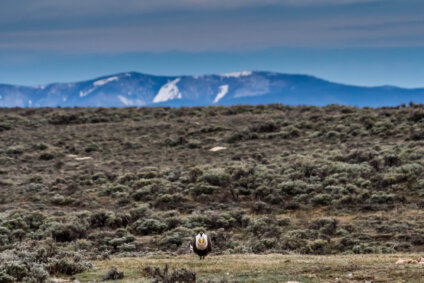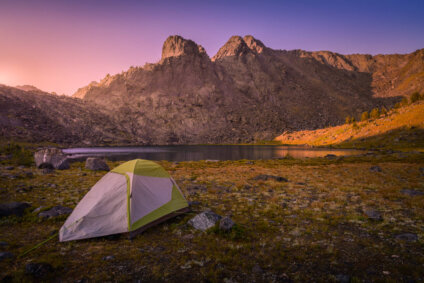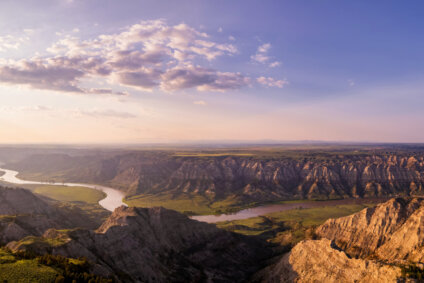Exploring the Wild Great Burn
Hiking the Montana-Idaho border
A few weeks ago I wrote a post about Montana Wilderness Association’s campaign to get Idaho’s portion of the Great Burn Area listed as “recommended wilderness” and the Chug for Charity event at Draught Works where MWA asked drinkers to send comment cards to the Clearwater National Forest. I was there, and although I could discuss the region’s importance as a wildlife corridor and make vague allusions to its beauty, I had never been to the Great Burn. With the belief that you can’t really fight for something without knowing what it is you are fighting for, I decided to make my first sojourn into the Great Burn.
After a series of well-maintained dirt roads, I arrived at the Clearwater Crossings trailhead. Only two other cars were parked in the lot, and once I slipped on my hiking boots, I was off—going up the North Fork of Fish Creek. The walking was pleasant with the creek next to me, babbling away, and after a few miles, I came to my first surprise of the day. Huckleberries! It was only a small patch that was actually fruiting, but a few minutes of picking yielded a heaping mound of delicious berries. I poured the handful down mouth and kept hiking. In another few miles, I passed the Greenwood Cabins, which were associated with an old mining claim that was more than a hundred years old. A half hour later, the trail wound me through a grove of enormous red cedars that gave the forest a primordial feel. So far, I was loving the Great Burn!
Eventually the trail brought me over a small pass, into Idaho and down to Goose Lake. The Montana portion of the Great Burn is already listed as recommended wilderness, so it is the Idaho side that is currently at issue. In Montana’s section, all road building, logging, and motorized vehicles are prohibited. But in Idaho, these are all still open to discussion or completely allowed, and motorized recreationists, especially snowmobilers, have fought the hardest to keep Idaho’s Great Burn from becoming recommended wilderness.
As I approached Goose Lake, this was on my mind. The eleven miles of trail I had just walked in Montana had been immaculate. Not only was the trail in great condition, but I did not detect a single sign of modernity. Unfortunately, this was not the case at Goose Lake. As I walked into one of the campsites on the shore of the lake, I crossed a small stream with a bottle of Dawn dish detergent lying next to it. In one of the fire rings lay a plastic gum package and some unburnt cigarette butts. Needless to say, I was disappointed. I had been in Idaho for no more than ten minutes and the difference was already stark.
I continued past the lake and began climbing back onto the Idaho-Montana border, where the trail spent the next nine miles. The views were gorgeous. From every direction, all I could see were mountains. Ridges were crossed by ridges, and it seemed like the mountains stretched forever. Civilization had made zero headway into any of the surrounding area, and I soaked in these views as I meandered along the ridge with only the tracks of bighorn sheep to keep me company.
After twenty long and wearisome miles, my goal was finally in sight. I could see Fish Lake, tucked below on the Idaho side of the border. Compared to the other lakes I had seen that day, Fish Lake was enormous, and it looked perfectly serene from my vantage. My pace quickened as I could not wait to shed my backpack and flop into my hammock. However, as I made the final approach to the lake, I was greeted by an unpleasant sight. First, I saw a privy—a welcomed but unusual sight considering I had seen no human development the entire day. Then an eerier sight: numbered campsites. At about the same time, I noticed large tire marks imprinted in the trail leading up to the lake. And just as my mind began to process their meaning, the gentle, yet disturbing hum of an ATV helped solve the riddle.
I had hiked twenty miles through pristine, wild country only to drop a half mile into Idaho and come to a place to which I could have driven. As I set up camp with the buzz of ATVs as background noise, I noticed little bits of trash strewn about the lake shore. It may sound extreme, but my entire day was ruined. I was exhausted, and all I wanted was to sit, gazing across the lake I had worked so hard to reach. But knowing that this lake was not a distant, well-kept secret, accessible only to those willing to put in the sweat and hard work, tarnished its beauty. After about a half hour, the ATVs vroomed back down the trail, and I had the lake to myself. Even so, I could not regain the sense of peace and solitude that they had obliterated.
On the way up to the border the next morning, there were a few signs prohibiting the use of motorized vehicles. It was a bittersweet reminder that, while Montana’s side of the Great Burn was protected from these uses, Idaho’s just as beautiful portion remained vulnerable to the excesses that accompany motorized use.
I completed the eleven miles back to the trailhead and did not see another soul until I was a few hundred yards from my destination. Despite my unfortunate findings at Goose Lake and Fish Lake, the trip was wonderful and it left me convinced, more than ever that the entire Great Burn region needs to be listed as recommended wilderness. Not only does it provide important habitat for wildlife and is home to a significant piece of the history of our public lands, but it is wild, magnificent country that should remain pristine and intact for future generations—something that will only happen if motorized use is prohibited.
Note: MWA will be continuing its campaign to list Idaho’s Great Burn as recommended wilderness throughout the summer. For more information on the campaign, visit http://www.greatburnstudygroup.org/
Michael Dax recently completed his masters degree in history at the University of Montana. He is an occasional contributer to High Country News and other publications. He's also an active volunteer with the Montana Wilderness Association in Missoula.
Stay Connected
"(Required)" indicates required fields


